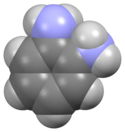
| |||
| |||

| |||
| Names | |||
|---|---|---|---|
| Preferred IUPAC name
Benzene-1,2-diamine | |||
| Other names
o-Phenylene diamine
1,2-Diaminobenzene 1,2-Phenylenediamine | |||
| Identifiers | |||
3D model (JSmol)
|
|||
| ChEBI | |||
| ChEMBL | |||
| ChemSpider | |||
| ECHA InfoCard | 100.002.210 | ||
| EC Number |
| ||
PubChem CID
|
|||
| RTECS number |
| ||
| UNII | |||
| UN number | 1673 | ||
CompTox Dashboard (EPA)
|
|||
| |||
| |||
| Properties | |||
| C6H8N2 | |||
| Molar mass | 108.144 g·mol−1 | ||
| Appearance | white solid | ||
| Density | 1.031 g/cm3 | ||
| Melting point | 102 to 104 °C (216 to 219 °F; 375 to 377 K) | ||
| Boiling point | 252 °C (486 °F; 525 K) Other sources: 256 to 258 °C (493 to 496 °F; 529 to 531 K) | ||
| soluble in hot water | |||
| Acidity (pKa) |
| ||
| -71.98·10−6 cm3/mol | |||
| Hazards | |||
| GHS labelling: | |||
   
| |||
| Danger | |||
| H301, H312, H317, H319, H332, H341, H351, H410 | |||
| P201, P202, P261, P264, P270, P271, P272, P273, P280, P281, P301+P310, P302+P352, P304+P312, P304+P340, P305+P351+P338, P308+P313, P312, P321, P322, P330, P333+P313, P337+P313, P363, P391, P405, P501 | |||
| NFPA 704 (fire diamond) | |||
| Flash point | 156 °C (313 °F; 429 K) | ||
| Safety data sheet (SDS) | Oxford MSDS | ||
Except where otherwise noted, data are given for materials in their standard state (at 25 °C [77 °F], 100 kPa).
| |||
o-Phenylenediamine (OPD) is an organic compound with the formula C6H4(NH2)2. This aromatic diamine is an important precursor to many heterocyclic compounds. OPD is a white compound although samples appear darker owing to oxidation by air. It is isomeric with m-phenylenediamine and p-phenylenediamine.
YouTube Encyclopedic
-
1/1Views:533
-
preparation of formic acid carboxylic acid class 12 chemistry subject notes lectures cbse
Transcription
Preparation
Commonly, 2-nitrochlorobenzene is treated with ammonia and the resulting 2-nitroaniline, whose nitro group is then reduced:[4]
- ClC6H4NO2 + 2 NH3 → H2NC6H4NO2 + NH4Cl
- H2NC6H4NO2 + 3 H2 → H2NC6H4NH2 + 2 H2O
In the laboratory, the reduction of the nitroaniline is effected with zinc powder in ethanol, followed by purification of the diamine as the hydrochloride salt. Darkened impure samples can be purified by treatment of its aqueous solution with sodium dithionite and activated carbon.[5]
Reactions and uses
o-Phenylenediamine condenses with ketones and aldehydes to give rise to various valuable products. Its reactions with formic acids to produce benzimidazole.[6] Other carboxylic acids give 2-substituted benzimidazoles. The herbicides benomyl and fuberidazole are made in this manner. Thiophanate-methyl is another herbicide produced from o-phenylenediamine.[4] Condensation with potassium ethylxanthate gives 2-mercaptobenzimidazole.[7] With nitrous acid, o-phenylenediamine condenses to give benzotriazole, a corrosion inhibitor.[8]
Quinoxalinedione may be prepared by condensation of o-phenylenediamine with dimethyl oxalate. Mercaptoimidazole are commonly used as antioxidants in rubber production, obtained by condensing xanthate esters. Condensation of substituted o-phenylenediamine with diketones yields various pharmaceuticals.[9]
OPD is a ligand in coordination chemistry. Oxidation of metal-phenylenediamine complexes affords the diimine derivatives.[10] OPD condenses with salicylaldehyde to give chelating Schiff base ligands.
Safety
With an LD50 of 44 mg/L (in water), o-phenylenediamine is about 1000 times less toxic than the para-isomer. Anilines are typically handled as if they are carcinogenic. For many applications, OPD has been replaced by safer alternatives such as 3,3',5,5'-tetramethylbenzidine.[11]
References
- ^ "DuPont Specialty Intermediates: o-Phenylenediamine (OPD)". Archived from the original on June 22, 2008. Retrieved April 25, 2006.
- ^ Haynes, William M., ed. (2016). CRC Handbook of Chemistry and Physics (97th ed.). CRC Press. p. 5–89. ISBN 978-1498754286.
- ^ "Hazardous Substances Data Bank (HSDB) : 2893 - PubChem". PubChem.
- ^ a b Smiley, Robert A. (2000). "Phenylene- and Toluenediamines". Ullmann's Encyclopedia of Industrial Chemistry. Weinheim: Wiley-VCH. doi:10.1002/14356007.a19_405. ISBN 978-3527306732.
- ^ E. L. Martin (1939). "o-Phenylenediamine". Organic Syntheses. 19: 70. doi:10.15227/orgsyn.019.0070.
- ^ Wagner, E. C.; Millett, W. H. (1939). "Benzimidazole". Organic Syntheses. 19: 12. doi:10.15227/orgsyn.019.0012.
- ^ VanAllan, J. A.; Deacon, B. D. (1950). "2-Mercaptobenzimidazole". Organic Syntheses. 30: 56. doi:10.15227/orgsyn.030.0056.
- ^ Damschroder, R. E.; Peterson, W. D. (1940). "1,2,3-Benzotriazole". Organic Syntheses. 20: 16. doi:10.15227/orgsyn.020.0016.
- ^ See for example, Renault, J.; et al. (1981). "Heterocyclic quinones. Quinoxaline-5,6 and 5,8 diones, potential antitumoral agents". Eur. J. Med. Chem. 16: 545–550.
- ^ Broere, Daniël L. J.; Plessius, Raoul; Van Der Vlugt, Jarl Ivar (2015). "New Avenues for Ligand-Mediated Processes – Expanding Metal Reactivity by the Use of Redox-Active Catechol, o-Aminophenol and o-Phenylenediamine Ligands". Chemical Society Reviews. 44 (19): 6886–6915. doi:10.1039/C5CS00161G. PMID 26148803.
- ^ Deshpande SS (1996). Enzyme Immunoassays: From Concept to Product Development. New York: Chapman & Hall. p. 169. ISBN 978-0-412-05601-7.



